Andy Yuill: Heating Scotland in a warming world


For those of us who have an interest in low-carbon energy, and specifically in low-carbon heating, there was a very interesting and welcome announcement from the Scottish Finance Secretary, who pledged investment of £137 million for energy-efficiency measures and decarbonisation of heat in 2018-19.
So what does this actually mean? It may surprise many that the largest use of energy in Scotland, and also the major source of climate-warming greenhouse gas emissions, is not electricity generation or transport. It is the heat we use in our homes and industries. Energy used in the form of heat is greater than electricity and transport combined. Great strides have been made in recent years to increase the amount of electricity from renewable sources, yet only five per cent of our heat comes from renewables.
Advertisement
Hide AdAdvertisement
Hide AdSince 2011, there has been a UK-wide support scheme called the Renewable Heat Incentive (RHI). Despite the scheme successfully kick-starting the adoption of renewable heat from a near standing start, the majority of this has been in areas of low housing density or in agricultural industries off the gas grid.
While this is good, if we are to make a meaningful impact on emissions from heating then we need to look at the fundamentals.
If the RHI got us started down the path, what is going to get us further along to the point where our homes are heated from sustainable low-emission sources?
The answer is a complex one since there is no one-size-fits-all solution. There is no golden technology that will address all the issues. To hit green goals will require our buildings and industries to be more heat-efficient. We will have to recover waste heat from industry and deliver it to homes using district heating networks. We must also find ways to harness new sources of heat, such as deep geothermal and recovered heat from abandoned mine workings. To do all this we first need to further develop knowledge and understanding among those responsible for our built environment. We then need to invest in pilot projects to demonstrate what is possible, to learn how best to apply existing technology in the Scottish context and to allow people to come and see what can be achieved in the delivery of low-carbon heat.
A lot of valuable work has already taken place in this area. There has been specific funding to build the knowledge and capacity of local authorities to identify opportunities for district heating. Pilot schemes have received backing to support their development from initial concept through the difficult stages of feasibility to shovel-ready projects, and matched funding has been put in place to support projects in securing private investment.
The new funding announced in the budget is designed to do just that, with £60m available to deliver innovative low-carbon energy infrastructure and further cash to support pilot projects.
This road is well travelled and the end goal of decarbonised heat is achievable. Our Scandinavian neighbours are already making big headway, with 70 per cent of heat in Sweden coming from renewable sources. This funding is well placed to help Scotland achieve the same result.
Andy Yuill is senior renewable heat manager at independent green energy and infrastructure consultancy Natural Power
